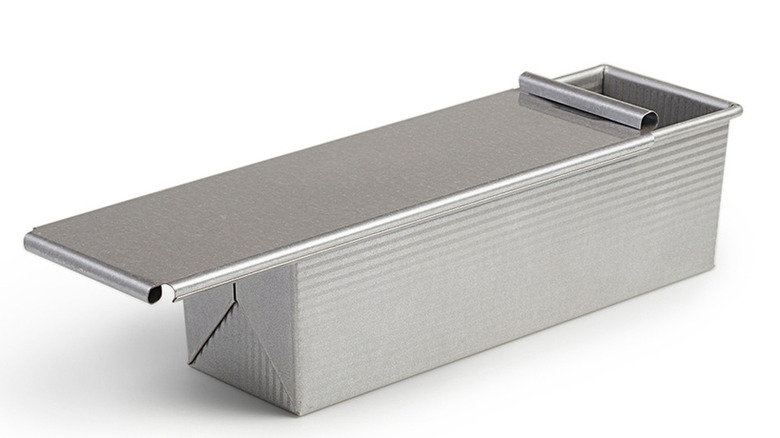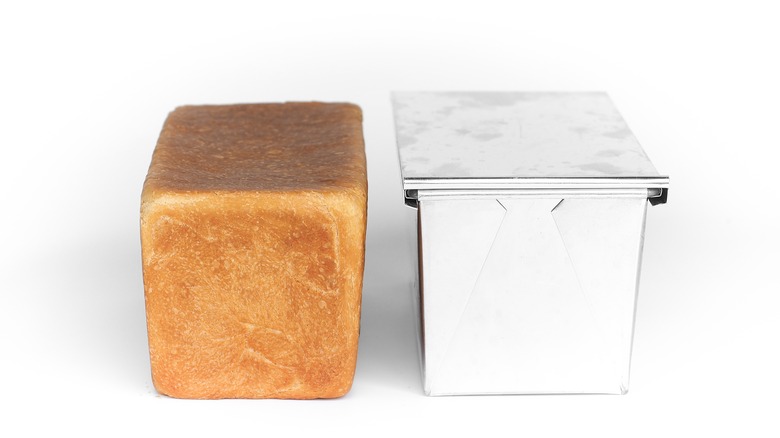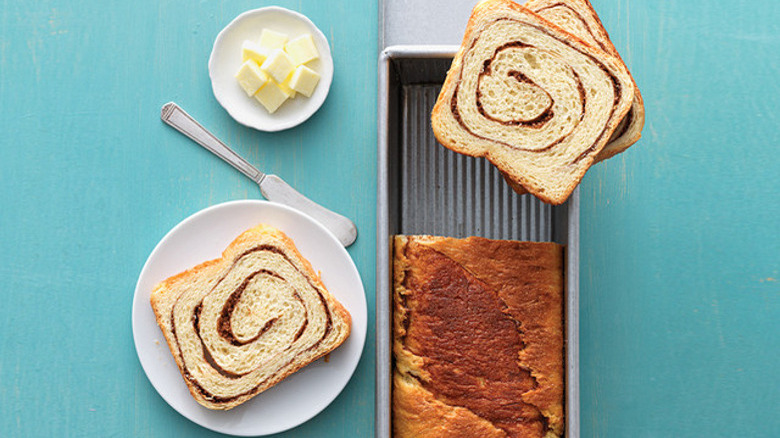Why Serious Bread Bakers Should Invest In A Pullman Loaf Pan
There's a whole world of bread to master and enjoy. From crusty, rustic loaves to tender enriched breads, baking often requires a fair amount of trial and error — along with a few specialized tools. The Pullman loaf pan may seem to be too specialized for a home baker, but once you've acquired one, you'll discover just how useful it can be. And while Cooks Info notes that Pullman loaf pans are more expensive than ordinary loaf pans, they're durable and built to last forever.
The Pullman loaf pan, also known as a pain de mie pan (via King Arthur), has straight, rather than sloped sides. The Pullman loaf pan is both taller and narrower than a traditional loaf pan – measuring 9x4x4 inches, rather than the traditional loaf pan measurements of 9x5x3 inches, according to Masterclass. The other distinguishing feature of the Pullman pan is that it comes with a lid, which Epicurious explains is why they were so frequently used on the passenger rail cars from which the loaf pans take their name. Pullman loaf pans, complete with the lid, stack more neatly, and use space more efficiently than traditional loaf pans. Since most home cooks don't necessarily need towering stacks of loaves of bread, why do you need a Pullman loaf pan in your kitchen? There are several reasons.
The Pullman loaf pan gives you a tender texture
If you're making sandwich bread — say, for a grilled cheese – you're typically looking for a tender, evenly shaped loaf of bread. Food to Impress suggests the Pullman loaf pan as the ideal solution if you're turning out bread with a crust that's tougher than you desire. Not only will your crust be tender, but the lid of the pan contains the rise in the oven, so you'll end up with that iconic-looking sandwich bread: even, square, and with a perfectly golden crust.
When you slice bread that's been baked in a Pullman pan, Cook's Info points out that you'll end up with picture-perfect square slices that may look store-bought but will taste so much better since they're homemade. Epicurious says these lovely slices are ideal for French toast, neat-as-a-pin croutons, and a classic croque monsieur. The Pullman loaf pan's usefulness extends beyond the simple sandwich, though. There are a number of special uses that make the pan even more practical for avid bakers.
How else can a Pullman loaf pan elevate your baking?
The Pullman loaf pan isn't just for sandwich bread. King Arthur Baking notes that it's ideal for any bread dough that's worked up to be a bit more slack than you might like. The narrower, taller profile of the pan gives extra support to bread dough that's wet and sticky without the need for additional flour. Also, bread recipes that are gluten or grain-free bake up higher and prettier in a Pullman pan than in a traditional loaf pan.
Another kind of bread that benefits from the Pullman loaf pan is any recipe that calls for flavorings that are swirled or rolled into the dough to create layers, like our luscious cinnamon swirl raisin bread. King Arthur Baking points out that the lid on the Pullman pan keeps the layers of dough and filling from separating while baking, resulting in gorgeous slices free of gaps between bread and filling. For similar reasons, we can attest that bread baked in this type of pan is excellent for bread pudding. And finally, Epicurious suggests using a Pullman loaf pan as a mold for ice cream cakes, terrines, and even pâté. In short, the Pullman loaf pan is a tool no serious baker should be without.


